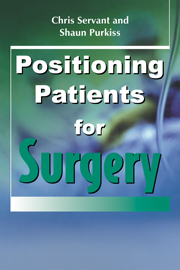Thoracic spine
Published online by Cambridge University Press: 06 December 2010
Summary
Prone position
(Figure 98)
Transfer the patient on to the operating table in the prone position. This requires rolling the patient from the supine position on to the arms of three or more assistants, who then lift the patient on to the operating table
In the prone position the patient must have their chest and pelvis supported so as to allow free movement of the abdomen. This may be achieved by lifting the patient on to a special mattress (e.g. the Montreal mattress) or frame (e.g. the Railton–Hall frame)
Rest the head on a suitable support (e.g. a pillow or a head ring)
Abduct the shoulders 90° and flex the elbows 90° so that the arms lie supported on a suitable arm board (move the arms through into position from the side in a front crawl swimming motion).
Considerations
Ensure that any pressure areas are well-padded: the knees, the pelvis, the external genitalia, the chest, the arms, the forehead.
Pad and tape the eyes.
The arms are best positioned on an arm board with the shoulders abducted 90° and the elbows flexed 90°.
Flex the knees slightly (e.g. over a pillow) to relieve tension on the sciatic nerves.
- Type
- Chapter
- Information
- Positioning Patients for Surgery , pp. 98 - 99Publisher: Cambridge University PressPrint publication year: 2009



